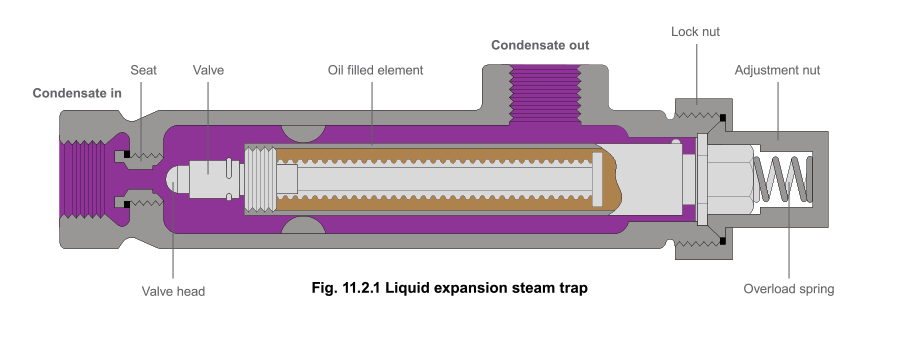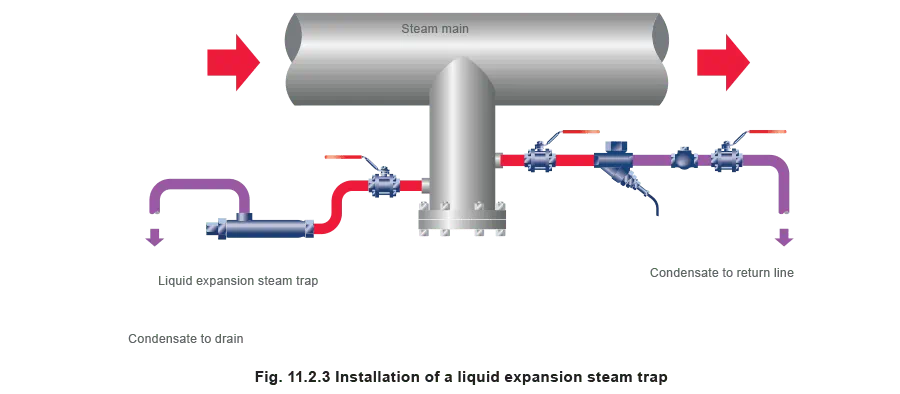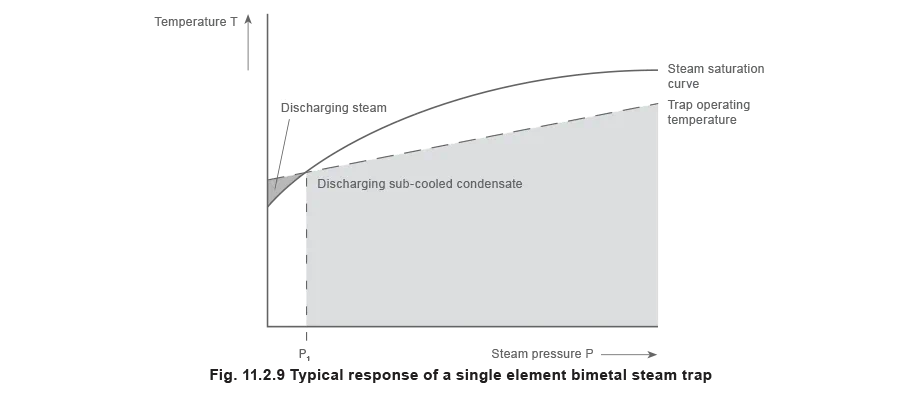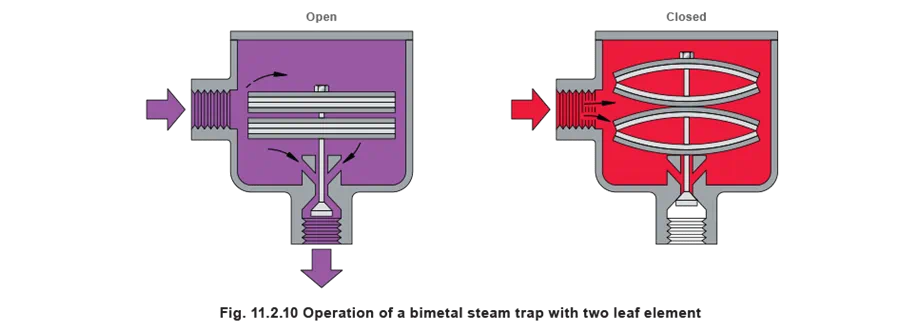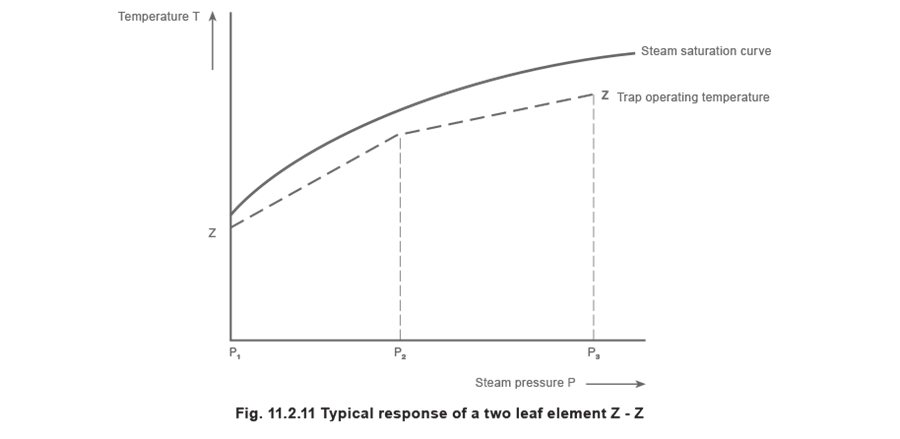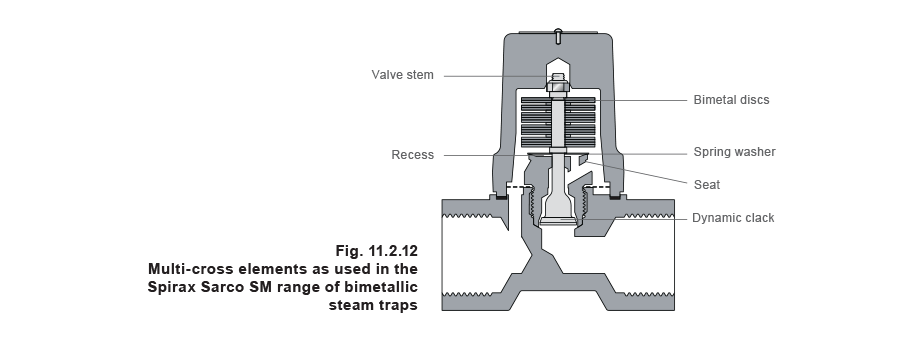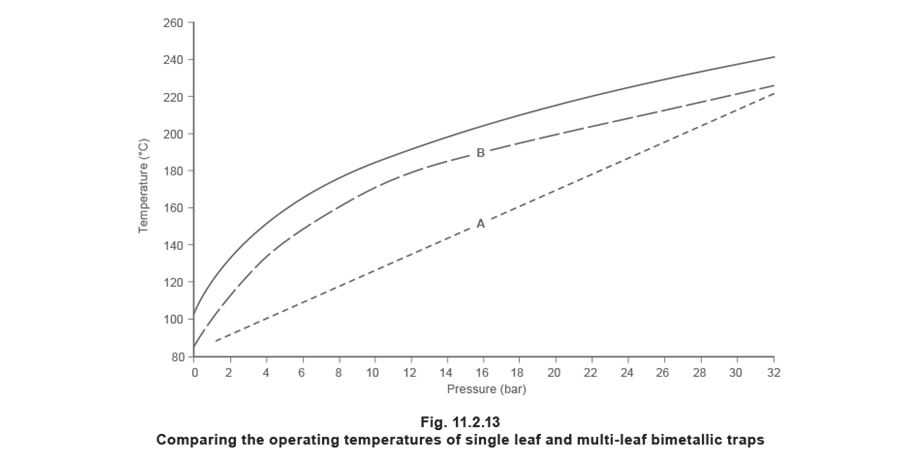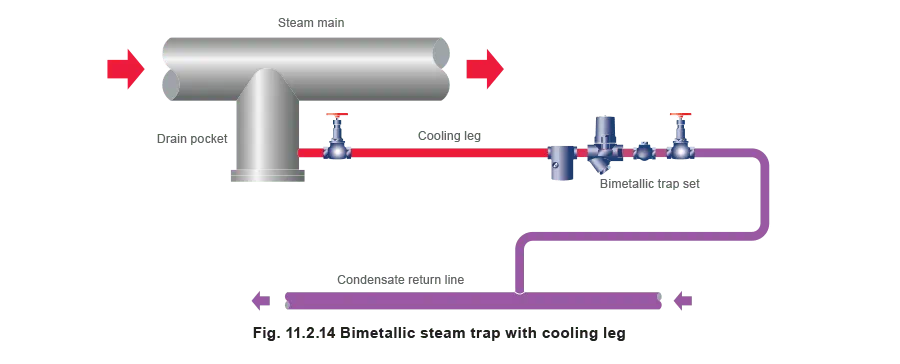Steam Traps and Steam Trapping

Contents
Thermostatic Steam Traps
Thermostatic traps operate in response to the surrounding steam temperature. The operation and benefits of 3 different types are considered here - liquid expansion traps, bimetallic and balanced pressure thermostatic traps. Each operates in a different way and is suited to specific types of application.
Liquid expansion steam trap
This is one of the simplest thermostatic traps and is shown in Figure 11.2.1. An oil filled element expands when heated to close the valve against the seat. The adjustment allows the temperature of the trap discharge to be altered between 60°C and 100°C, which makes it ideally suited as a device to get rid of large quantities of air and cold condensate at start-up.
As discussed in Module 2.2, the temperature of saturated steam varies with pressure.
Figure 11.2.2 shows the saturation curve for steam, together with the fixed temperature response line (X - X) of the liquid expansion trap, set at 90°C.
It can be seen from Figure 11.2.2 that when the pressure is at pressure P1, condensate would have to cool by only a small amount (ΔT1), and trapping would be acceptable. However, if pressure is increased to P2 then condensate has to cool more (ΔT2) to pass through the steam trap. This cooling can only occur in the pipe between the process and trap, and if the trap discharge temperature remains constant, the process will waterlog.
Typical application
Because of its fixed temperature discharge characteristic, the liquid expansion trap may be usefully employed as a ‘shutdown drain trap’. Here, its outlet must always point upwards, as illustrated in Figure 11.2.3, to enable continuous immersion of the oil filled element. As the trap can only discharge between 60°C - 100°C it will only normally open during start-up. It can be installed alongside a mains drain trap which would normally be piped to a condensate return line.
Advantages of the liquid expansion steam trap:
• Liquid expansion traps can be adjusted to discharge at low temperatures, giving an excellent ‘cold drain’ facility.
• Like the balanced pressure trap, the liquid expansion trap is fully open when cold, giving good air discharge and maximum condensate capacity on ‘start-up’ loads.
• The liquid expansion trap can be used as a start-up drain trap on low pressure superheated steam mains where a long cooling leg is guaranteed to flood with cooler condensate. It is able to withstand vibration and waterhammer conditions.
Disadvantages of the liquid expansion steam trap:
• The flexible tubing of the element can be destroyed by corrosive condensate or superheat.
• Since the liquid expansion trap discharges condensate at a temperature of 100°C or below, it should never be used on applications which demand immediate removal of condensate from the steam space.
• If the trap is to be subjected to freezing conditions the trap and its associated pipework must be well insulated.
• The liquid expansion trap is not normally a trapping solution on its own, as it usually requires another steam trap to operate in parallel. However, it can often be used where start-up rate is not an important consideration, such as when draining small tank heating coils.
Balanced pressure steam trap
A large improvement on the liquid expansion trap is the balanced pressure trap, shown in Figure 11.2.4. Its operating temperature is affected by the surrounding steam pressure. The operating element is a capsule containing a special liquid and water mixture with a boiling point below that of water. In the cold conditions that exist at start-up, the capsule is relaxed. The valve is off its seat and is wide open, allowing unrestricted removal of air. This is a feature of all balanced pressure traps and explains why they are well suited to air venting.
As condensate passes through the balanced pressure steam trap, heat is transferred to the liquid in the capsule. The liquid vaporises before steam reaches the trap. The vapour pressure within the capsule causes it to expand and the valve shuts. Heat loss from the trap then cools the water surrounding the capsule, the vapour condenses and the capsule contracts, opening the valve and releasing condensate until steam approaches again and the cycle repeats (Figure 11.2.5).
The differential below steam temperature at which the trap operates is governed by the concentration of the liquid mixture in the capsule. The ‘thin-walled’ element gives a rapid response to changes in pressure and temperature. The result is the response line as illustrated in Figure 11.2.6.
Early bellows type elements of non-ferrous construction were susceptible to damage by waterhammer. The introduction of stainless steel elements improved reliability considerably. Figure 11.2.7 shows an exploded view of a modern balanced pressure steam trap arrangement that has considerable resistance to damage from waterhammer, superheat and corrosion.
Advantages of the balanced pressure steam trap:
• Small, light and has a large capacity for its size.
• The valve is fully open on start-up, allowing air and other non-condensable gases to be discharged freely and giving maximum condensate removal when the load is greatest.
• This type of trap is unlikely to freeze when working in an exposed position (unless there is a rise in the condensate pipe after the trap, which would allow water to run back and flood the trap when the steam is off).
• The modern balanced pressure trap automatically adjusts itself to variations of steam pressure up to its maximum operating pressure. It will also tolerate up to 70°C of superheat.
• Trap maintenance is simple. The capsule and valve seat are easily removed, and replacements can be fitted in a few minutes without removing the trap from the line.
Disadvantages of the balanced pressure steam trap:
• The older style balanced pressure steam traps had bellows which were susceptible to damage by waterhammer or corrosive condensate. Welded stainless steel capsules introduced more recently, are better able to tolerate such conditions.
• In common with all other thermostatic traps, the balanced pressure type does not open until the condensate temperature has dropped below steam temperature (the exact temperature difference being determined by the fluid used to fill the element). This is clearly a disadvantage if the steam trap is chosen for an application in which waterlogging of the steam space can not be tolerated, for example; mains drainage, heat exchangers, critical tracing.
Bimetallic steam trap
As the name implies, bimetallic steam traps are constructed using two strips of dissimilar metals welded together into one element. The element deflects when heated. (Figure 11.2.8):

There are two important points to consider regarding this simple element:
• Operation of the steam trap takes place at a certain fixed temperature, which may not satisfy the requirements of a steam system possibly operating at varying pressures and temperatures (see Figure 11.2.9).
• Because the power exerted by a single bimetal strip is small, a large mass would have be used which would be slow to react to temperature changes in the steam system.
The performance of any steam trap can be measured by its response to the steam saturation curve. The ideal response would closely follow the curve and be just below it. A simple bimetal element tends to react to temperature changes in a linear fashion.
Figure 11.2.9 shows the straight line characteristic of a simple bimetal element relative to the steam saturation curve. As steam pressure increases above P1, the difference between steam saturation temperature and trap operating temperature would increase. Waterlogging increases with system pressure, highlighting the trap’s inability to respond to changing pressure conditions.
It needs to be noted that at pressures below P1, the steam trap operating temperature is actually above the saturation temperature. This would cause the steam trap to pass steam at these lower pressures. It may be possible to ensure the steam trap is adjusted during manufacture to ensure that this portion of the saturation curve is always above the operating line. However, due to the linear action of the element, the difference between the two would increase even more with system pressure, increasing the waterlogging effect.
Clearly, this is not a satisfactory operation for any steam trap, and various attempts have been made by manufacturers to improve upon the situation. Some use combinations of two different sets of bimetal leaves in a single stack, which operate at different temperatures (Figure 11.2.10).
The typical result is the split response line similar to that shown in Figure 11.2.11. This is an improvement on Figure 11.2.9, but still does not exactly follow the saturation curve. One set of bimetal leaves deflect to give the response P1 to P2. At a higher temperature a second set of bimetal leaves contributes to give response P2 to P3. Clearly, although an improvement from the former design, this is still unsatisfactory in terms of following the saturation curve.
A more innovative design is the disc spring thermostatic element shown in Figure 11.2.12. The thermostatic element is made up of a set of bimetal discs. These discs, if acting directly between the valve stem and the seat (as with some thermostatic steam traps), cause the discharge temperature of the condensate to change linearly with changing pressure (curve ‘A’, Figure 11.2.13). By incorporating a spring washer between the discs and a recess in the seat, this absorbs some of the bimetal expansion at low pressure so that a greater temperature change must occur with changing pressure. The spring washer shape is preferred over a coil spring because it develops force in an exponentially increasing rate, rather than in a linear rate. This effect takes place up to 15 bar g until the spring is deflected to the bottom of the recess, and means that the discharge temperature of the condensate will follow the steam saturation curve more accurately (curve ‘B’, Figure 11.2.13). Discharge rates are also improved by the dynamic clack which tends to produce a blast discharge.
Advantages of the bimetallic steam trap:
• Bimetallic steam traps are usually compact, yet can have a large condensate capacity.
• The valve is wide open when the steam trap is cold, giving good air venting capability and maximum condensate discharge capacity under 'start-up' conditions.
• As condensate tends to drain freely from the outlet, this type of steam trap will not freeze up when working in an exposed position. The bodies of some bimetallic steam traps are designed in such a way that they will not receive any damage even if freezing does occur.
• Bimetallic steam traps are usually able to withstand waterhammer, corrosive condensate, and high steam pressures.
• The bimetal elements can work over a wide range of steam pressures without any need for a change in the size of the valve orifice.
• If the valve is on the downstream side of the seat, it will tend to resist reverse flow through the steam trap. However, if there is any possibility of reverse flow, a separate check valve should be fitted downstream of the trap.
• As condensate is discharged at varying temperatures below saturation temperature and, provided waterlogging of the steam space can be tolerated, some of the enthalpy of saturated water can be transferred to the plant. This extracts the maximum energy from the condensate before it drains to waste, and explains why these traps are used on tracer lines where condensate is often dumped to waste.
• Maintenance of this type of steam trap presents few problems, as the internals can be replaced without removing the trap body from the line.
• The flash steam produced whenever condensate is discharged from a higher to a lower pressure will tend to cause an increase in backpressure in the condensate line. The cooling leg allows the condensate to cool down, producing less flash steam in the condensate line and thus helping to reduce the backpressure.
Disadvantages of the bimetallic steam trap:
• As condensate is discharged below steam temperature, waterlogging of the steam space will occur unless the steam trap is fitted at the end of a long cooling leg, typically 1 - 3 m of unlagged pipe (see Fig. 11.2.14). Bimetallic steam traps are not suitable for fitting to process plants where immediate condensate removal is vital for maximum output to be achieved. This is particularly relevant on temperature controlled plants.
• Some bimetallic steam traps are vulnerable to blockage from pipe dirt due to low internal flow velocities. However, some bimetallic traps have specially shaped valve trims that capture the discharge energy to open the valve more. These tend to give an intermittent blast discharge characteristic rather than a continual dribble discharge, and as such tend to be self-cleaning. These valve trims are sometimes referred to as dynamic clacks.
• If the bimetallic steam trap has to discharge against a significant backpressure, the condensate must cool to a lower temperature than is normally required before the valve will open. A 50% backpressure may cause up to a 50°C drop in discharge temperature. It may be necessary to increase the length of cooling leg to meet this condition.
• Bimetallic steam traps do not respond quickly to changes in load or pressure because the element is slow to react.
Highlighted products

BT6 Balanced Pressure Steam Trap
The BT6 316L stainless steel balanced pressure steam trap is specifically designed for hygienic applications including steam barriers, CIP/SIP and process vessel drainage, sterilisers and autoclaves, and culinary steam mains drainage.

FTS14 Ball Float Steam Trap
The requirement for 316 stainless steel is gradually being extended to secondary side media such as steam and hot water.

TD62M and TD62LM
The TD62LM and TD62M are maintainable high pressure thermodynamic steam traps with integral strainer and a replaceable seat to ease maintenance.

